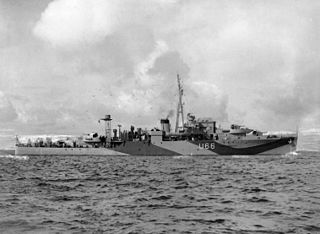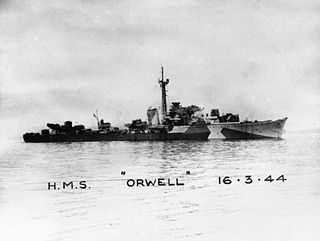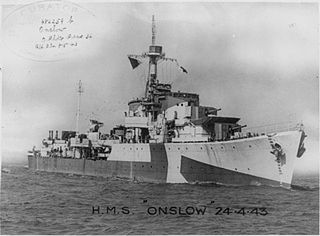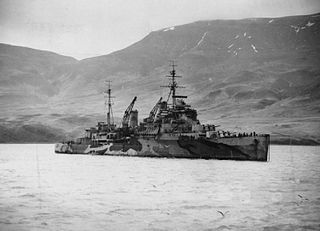
The Battle of the North Cape was a Second World War naval battle that occurred on 26 December 1943, as part of the Arctic campaign. The German battleship Scharnhorst, on an operation to attack Arctic convoys of war materiel from the western Allies to the Soviet Union, was brought to battle and sunk by the Royal Navy's battleship HMS Duke of York with cruisers and destroyers, including an onslaught from the destroyer HNoMS Stord of the exiled Royal Norwegian Navy, off the North Cape, Norway.

The Arctic convoys of World War II were oceangoing convoys which sailed from the United Kingdom, Iceland, and North America to northern ports in the Soviet Union – primarily Arkhangelsk (Archangel) and Murmansk in Russia. There were 78 convoys between August 1941 and May 1945, sailing via several seas of the Atlantic and Arctic oceans, with two gaps with no sailings between July and September 1942, and March and November 1943.

HMS Starling, pennant number U66, was a Modified Black Swan-class sloop of the Royal Navy. She was active in the Battle of the Atlantic during the Second World War and was the most successful anti-submarine warfare vessel of the Royal Navy, being credited with the destruction of fourteen U-boats.

Operation Sportpalast, also known as Operation Nordmeer, was a German naval raid between 6 and 13 March 1942 against two of the Allied Arctic convoys of World War II as they passed through the Norwegian Sea. It was conducted by the battleship Tirpitz, three destroyers and eight submarines. The German ships were unable to locate either of the convoys but sank a merchant vessel that was sailing independently. The Allies attempted to intercept the German force, also without success.

HMS Orwell was an O-class destroyer of the Royal Navy that entered service in 1942 and was broken up in 1965.

HMS Onslow was an O-class destroyer of the Royal Navy. The O-class were intermediate destroyers, designed before the outbreak of the Second World War to meet likely demands for large number of destroyers. They had a main gun armament of four 4.7 in guns, and had a design speed of 36 kn. Onslow was ordered on 2 October 1939 and was built by John Brown & Company at their Clydebank, Glasgow shipyard, launching on 31 March 1941 and completing on 8 October 1941.

PQ 13 was a British Arctic convoy that delivered war supplies from the Western Allies to the USSR during World War II. The convoy was subject to attack by German air, U-boat and surface forces and suffered the loss of five ships, plus one escort vessel. Fifteen ships arrived safely.

HMS Keppel was a Thornycroft type flotilla leader built for the Royal Navy at the end of the First World War. She was completed too late to serve in that conflict, but saw extensive service in the inter war years and in World War II. She was an effective convoy escort and U-boat killer, being credited with the destruction of five U-boats during the Battle of the Atlantic. She was the second of three ships named for 18th century Admiral Augustus Keppel.

Convoy JW 57 was an Arctic convoy sent from Great Britain by the Western Allies to aid the Soviet Union during World War II. It sailed in February 1944, reaching the Soviet northern ports at the end of the month. All ships arrived safely. For several days JW 57 was attacked by a German U-boat force; one escort vessel was sunk, and two U-boats were destroyed in counter-measures, during this operation.
Convoy JW 56A was an Arctic convoy sent from Great Britain by the Western Allies to aid the Soviet Union during World War II. It sailed in January 1944, reaching the Soviet northern ports at the end of the month. Twelve ships arrived safely. During the voyage JW 56A was attacked by a German U-boat force; three ships were sunk and one of the escorts damaged in the operation.

Convoy JW 56B was an Arctic convoy sent from Great Britain by the Western Allies to aid the Soviet Union during World War II. It sailed in late January 1944, reaching the Soviet northern ports at the beginning of February. All ships arrived safely. During the voyage JW 56B was attacked by a German U-boat force; no merchant ships were sunk, though one of the escorts was lost. One attacking U-boat was destroyed in the operation.
Convoy JW 55A was an Arctic convoy sent from Great Britain by the Western Allies to aid the Soviet Union during World War II. It sailed in December 1943, reaching the Soviet northern ports at the end of the month. All ships arrived safely.

Convoy JW 55B was an Arctic convoy sent from Great Britain by the Western Allies to aid the Soviet Union during World War II. It sailed in late December 1943, reaching the Soviet northern ports at the end of the month. All ships arrived safely.
Convoy RA 55A was an Arctic convoy during World War II. It was one of a series of convoys run to return Allied ships from Soviet northern ports to ports in Britain. It sailed in late December 1943, reaching British ports at the end of the month. All ships arrived safely.
Convoy JW 54A was an Arctic convoy sent from Great Britain by the Western Allies to aid the Soviet Union during World War II. It sailed in November 1943, reaching the Soviet northern ports at the end of the month. JW 54A was the first out-bound Arctic convoy of the 1943–44 winter season, following their suspension during the summer. All ships arrived safely.
Convoy JW 54B was an Arctic convoy sent from Great Britain by the Western Allies to aid the Soviet Union during World War II. It sailed in late November 1943, reaching the Soviet northern ports at the end of the month. All ships arrived safely.
Convoy JW 51A was an Arctic convoy sent from Great Britain by the Western Allies to aid the Soviet Union during World War II. It sailed in December 1942, reaching the Soviet northern ports at the end of the month.
Convoy JW 51B was an Arctic convoy sent from United Kingdom by the Western Allies to aid the Soviet Union during World War II. It sailed in late December 1942, reaching the Soviet northern ports in early January 1943.

Arctic naval operations of World War II were the World War II naval operations that took place in the Arctic Ocean, and can be considered part of the Battle of the Atlantic and/or of the European Theatre of World War II.

Operation Goodwood was a series of British carrier air raids conducted against the German battleship Tirpitz at her anchorage in Kaafjord in occupied Norway during late August 1944. It was the last of several attacks made by the Home Fleet during 1944 which sought to damage or sink Tirpitz and thereby eliminate the threat it posed to Allied shipping. Previous raids on Kaafjord conducted by Fleet Air Arm aircraft had involved only one air attack; in Operation Goodwood several attacks were made in a single week. The Royal Navy hoped that these raids would wear down the formidable German defences.













